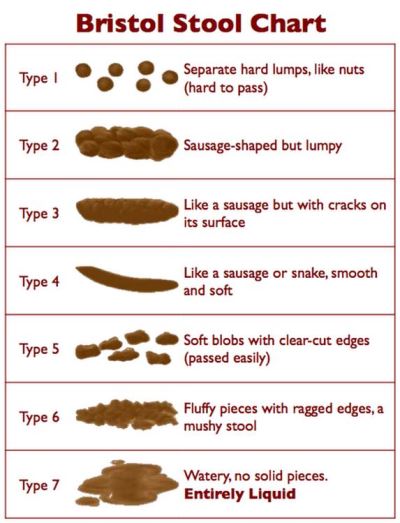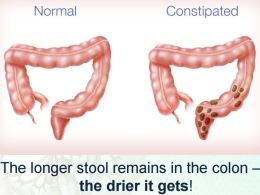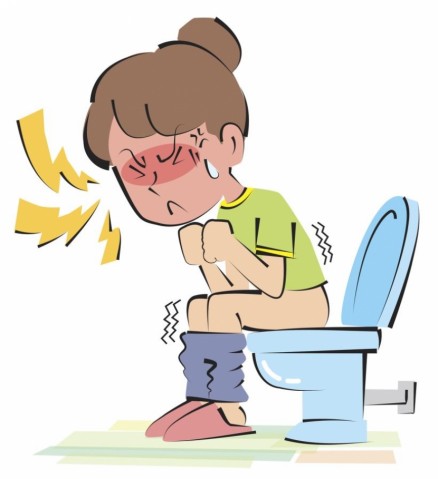DrCarney.com Blog
The Scoop on Poop
For most people, discussing bowel function can be almost as painful as being constipated! Although it is an embarrassing topic for many, most people are concerned whether or not their bowel habits are normal. If you're curious about this topic, you've come to the right place. We address the most frequently asked questions and will explain how bowel habits will change dramatically for those making the transition from the standard American diet to a whole-food, plant-based diet.
Because bowel habits aren't discussed during routine office visits, patients don't consider this bodily function to be of great importance. Yet bowel habits such as frequency, consistency, color, and content are important markers which represent a patient's overall health and are an important tool in predicting future risk for possible life-threatening illnesses. Considering that bowel function reflects the healthfulness and composition of one's diet, it should be considered a vital sign like pulse and respiration rate, temperature and blood pressure.
Frequency - It's all About the Fiber!
Moving the bowels is an infrequent and uncomfortable or even painful experience for the majority of Americans. Having one bowel movement a few times a week, one a week or even one every other week is customary for those who consume a fiber-deficient diet. Fiber is the thread-like structure which is found ONLY in whole or minimally processed plant foods. Meat, dairy, eggs, sugary drinks and oil contain NO fiber and processed food contains MINIMAL or no fiber. In contrast, unprocessed plant food supplies an abundance of fiber, more than twice the recommended minimum daily intake. Most Americans consuming the standard American diet barely eat 10-15 grams of fiber per day, whereas a plant-based diet can easily provide 60 to 100+ grams per day. It's easy to see why 97% of Americans are deficient in this important nutrient.
Fiber comes in two forms, soluble and insoluble. Both types provide the "framework" or bulk/volume to the stool. Insoluble fiber does not soak up water, it passes through the gastrointestinal tract relatively intact. It provides bulk and acts as a laxative by speeding up the time in which it takes for digested food to be removed from the colon. Unlike insoluble fiber, soluble fiber does attract water. It turns into a jell-like substance which produces bulky, soft and loosely-formed stools. After the carbohydrates, proteins, vitamins and minerals have been absorbed by the small intestine, these non-digestible fibers (along with microorganisms) remain to form the bulk of the stool.
Americans are constipated! Over $725 million is spent each year on laxatives. Constipation is as American as baseball and apple pie. It's the most common gastrointestinal complaint resulting in millions of visits to the doctor. Constipation is generally defined as having difficulty in passing hard or infrequent bowel movements - three or fewer per week. Those that follow low-carb diets like the Atkins diet are especially prone to constipation due to the diet being high in animal products (no fiber) and low in carbohydrate-containing whole plant foods (high in fiber).
How Many Times Should those Eating a Healthful Diet "Go?"
Concerns arise in many people after they transition to a whole-food, plant-centered diet. Due to the high fiber content in whole plant foods, the frequency of moving the bowel contents increases significantly. Many people discover that they were constipated eating their previous diet, but didn't realize it because the (lack of) frequency of which they moved their bowels since childhood was "normal" to them. Populations thriving on traditional starch-centered, plant-based diets however have between two to three movements a day, or a movement for every meal. Eating more raw vegetables and beans and strenuous exercise can sometimes increase the number of movements in some people to four and even five a day. Check out the Mayo Clinic's list of high-fiber content in various plant foods. Beans are exceptionally high in fiber.
"Most people have bowel movements one to three times a day, usually in the morning" Dr. McDougall writes. "However, others will easily pass their soft stool as infrequently as every other day - and this is right for them. Most important is the consistency of the matter and the ease with which it is eliminated. The criterion I use for deciding what is normal is that the stool should be moderately soft and easy to pass without pain or strain. The accumulation of feces between movements should not reach the point where severe bloating of the intestine and discomfort occur. When first starting the McDougall Diet the bowels may seem overactive, but they settle down to a more normal pattern in one to two weeks as the body begins to adjust to this new, more healthful way of eating."
For those of you who are looking for information regarding ulcerative colitis, irritable bowel, and inflammatory bowel disease, check out the following pages by Dr. McDougall: Mild Colitis, Severe Colitis, and Chronic Colitis.
Does Shape and Size Matter?
When it comes to stool size, bigger is better! Diets consisting of meat, dairy, oils, eggs and processed foods produce small, separate, "rock-hard" stools resembling marbles, grapes, or corn-on-the-cob. Remarkably, the colon absorbs six quarts of water back into the bloodstream every day. Thus, water from the stool is absorbed by the colon as it makes its journey to the rectum. Fiber- deficient stools are small and dry because they lack the volume and moistness which insoluble/soluble fiber provides. These stools move slowly through the intestines, becoming harder and drier from water loss the longer they stay. Plant-based diets produce large, soft and moist stools which range from looking like a smooth sausage (Type 4 on the chart to the right) to what Dr. John McDougall describes as an unformed "cow-plop." (An example of this can be seen in the image below.) Larger, heavier stools move quickly through the intestines. Stools are usually about an inch in diameter, have the consistency of toothpaste and can vary in color (from yellow, orange, to brown) depending on which foods are consumed since various vegetables have distinct colors. (Black, clay colored and red stools could indicate serious gastrointestinal bleeding or liver/gallbladder/pancreas trouble which should be evaluated by your physician without delay.) Click here to watch Dr. Michael Greger's video that explains the Bristol Stool Scale. This scale is a useful medical tool that classifies stool forms. Bet you didn't know that existed! Dr. Greger says that only a small minority of adults exhibit normal bowel function and the bigger the stool, the healthier we may be.
deficient stools are small and dry because they lack the volume and moistness which insoluble/soluble fiber provides. These stools move slowly through the intestines, becoming harder and drier from water loss the longer they stay. Plant-based diets produce large, soft and moist stools which range from looking like a smooth sausage (Type 4 on the chart to the right) to what Dr. John McDougall describes as an unformed "cow-plop." (An example of this can be seen in the image below.) Larger, heavier stools move quickly through the intestines. Stools are usually about an inch in diameter, have the consistency of toothpaste and can vary in color (from yellow, orange, to brown) depending on which foods are consumed since various vegetables have distinct colors. (Black, clay colored and red stools could indicate serious gastrointestinal bleeding or liver/gallbladder/pancreas trouble which should be evaluated by your physician without delay.) Click here to watch Dr. Michael Greger's video that explains the Bristol Stool Scale. This scale is a useful medical tool that classifies stool forms. Bet you didn't know that existed! Dr. Greger says that only a small minority of adults exhibit normal bowel function and the bigger the stool, the healthier we may be.
How Much Effort is Required?
The last few inches of the large intestine (colon) is called the rectum. When this segment of the colon becomes adequately filled with fecal matter, it engages a reflex which initiates the elimination process. Dr. McDougall points out in his article In Search of the Perfect Bowel Movement that when there isn't sufficient fiber in the diet, there's not enough material to form a stool to activate this reflex. This results in a few small rock-hard fecal marbles that requires tremendous muscular straining and exertion to pass. Moving these fiber-deficient stools can be both time consuming and painful. Reading the newspaper has become a customary practice while this process takes place, along with numerous grunts and groans. The feeling of incomplete emptying generally follows. In contrast, stools which contain an abundance of fiber from whole plant foods are bulky and moist. They move quickly through the intestines and are passed effortlessly, without any pain or straining, followed by the feeling of complete emptying. Only one brief abdominal push is required, with no exertion or repeated bearing down. The time required to move soft stools is reduced to ten-fifteen seconds; under one minute at the most.
Are there any Long-Term Effects Associated with Constipation?
Constipation is not just an uncomfortable annoyance. Years of eating a rich diet based on meat, dairy, eggs, oils and processed/refined foods significantly increases the risk of developing the conditions below:
Cancer Constipation promotes many illnesses requiring large hospitals while healthy bowels eliminate this need. - Since stools with minimal fiber content move through the intestines slowly, toxins/carcinogens from the food we have eaten (especially animal products) have more time to be absorbed into the bloodstream. Longer exposure time of these toxins are associated with an increased risk of many types of cancers, including bowel cancer. Additional information in this presentation by Michael Klaper MD.
Constipation promotes many illnesses requiring large hospitals while healthy bowels eliminate this need. - Since stools with minimal fiber content move through the intestines slowly, toxins/carcinogens from the food we have eaten (especially animal products) have more time to be absorbed into the bloodstream. Longer exposure time of these toxins are associated with an increased risk of many types of cancers, including bowel cancer. Additional information in this presentation by Michael Klaper MD.
Diverticular disease - Years of straining to move small, rock-hard stools creates high levels of pressure inside the colon which eventually causes the walls of the colon to rupture - forming pockets called diverticula. Those that consume meat on a regular basis have a much higher incidence of diverticular disease than those that eat a plant-centered diet. More information in the video by Dr. Greger entitled Diverticulosis: When Our Most Common Gut Disorder Hardly Existed.
Colon Polyps - Polyps are a consequence of chronic irritation of the intestinal wall. This irritation is caused by hard, dry stools passing through the intestines. Consequently, abrasions (polyps) are formed, much like a callus on the palm of the hand. Polyps subjected to constant irritation form protective layers of tissue for protection, thus increasing in size. Read my blog Healthy Food = Healthy Colon for more information.
Appendicitis - Appendicitis is unknown in populations that eat traditional plant/starch based diets consisting of whole grains, beans, vegetables and fruit. Dr. McDougall explains that "When the opening of the appendix becomes blocked, fluids accumulate. These stagnant fluids become infected creating a disease condition common to Westerners, called appendicitis. The cause of this blockage is unhealthy remnants of partially digested foods, which irritate the opening of the appendix."
Varicose veins - Veins in the legs become damaged from prolonged straining needed to move difficult bowel movements. High pressures from straining stretch and damage the valves of the veins so that the flow of blood is interrupted. Blood then collects in these veins between the stretched valves. Varicose veins can also occur in the scrotum of men and the vulva and around the ovaries in women. More information can be found in Dr. McDougall's article Constipation, Hemorrhoids, Varicose Veins.
Anal fissures - Passing large and dry stools causes tears in the soft delicate tissues lining the anus, resulting in pain and bleeding.
Hemorrhoids - Hemorrhoids are veins located in the last few inches of the intestinal tract. Years of straining to move hard and dry stool creates increased pressure on these veins, filling them beyond their natural ability. As a result, they stretch and become permanently dilated bulges that protrude out of the rectum. The anal muscles can also eventually be pushed outward, contributing to this painful condition. More information can be found in this article entitled Straining for Relief – Damage Everywhere by Dr. McDougall.
Hiatal hernia - Excessive intra-abdominal pressure from bearing down during burdensome bowel movements causes an upward pressure which forces a part of the stomach and esophagus to bulge through the diaphragm up into the chest. The simple act of breathing draws acid up into the mouth, lungs and esophagus which cause erosion of the lining of the esophagus, sinusitis, asthma, and loss of dental enamel (GERD). Half of Americans over the age of 50 have stretched their diaphragm muscle permanently subjecting them to a hiatal hernia.
Fainting and Sudden Death - Dr. Greger reports, "Protracted straining can cause heart rhythm disturbances, reduction in blood flow to the heart and brain, sometimes resulting in related fainting and death. Fifteen seconds of straining can temporarily cut blood flow to the brain by 21% and cut blood flow to the heart nearly in half - thereby providing a mechanism for the well-known bedpan death syndrome. Bearing down for just a few seconds can send your blood pressure up to nearly 170 over 110 which may help account for the notorious frequency of sudden and unexpected deaths of patients while using bed pans in hospitals."
Prolapse of the female uterus, spermatocele (dilation of the spermatic cord), cystocele (prolapse of the female bladder), and rectocele (prolapse of the rectum) are additional conditions Dr. McDougall believes are caused from laborious straining to move hard stools.
What Factors Contribute to Constipation?
Common factors include: The single most leading factor which contributes to constipation is eating a diet which is based heavily on meats, dairy, eggs, and processed/refined foods. Dairy consumption is another leading factor, especially in children. Other factors include inadequate hydration and lack of physical exercise. Remember, meat/dairy/oils/eggs have Fiber-deficient stools pass through the colon slowly, resulting in hard, dry, small stools. zero fiber and the majority or all of the fiber has been removed from refined/processed foods. Considering that nearly 90% of calories from the rich Western diet comes from foods which are void of any fiber - meat, dairy, eggs, refined grains, oils, butter, shortening, candy, sodas, and potato chips, it's no surprise that nearly all Americans are severely deficient in both fiber and micronutrient intake.
Fiber-deficient stools pass through the colon slowly, resulting in hard, dry, small stools. zero fiber and the majority or all of the fiber has been removed from refined/processed foods. Considering that nearly 90% of calories from the rich Western diet comes from foods which are void of any fiber - meat, dairy, eggs, refined grains, oils, butter, shortening, candy, sodas, and potato chips, it's no surprise that nearly all Americans are severely deficient in both fiber and micronutrient intake.
Other less common factors are: anal fissures and hemorrhoids, diseases of the nervous system, immobility and inconvenience, laxative use, medications (opioid narcotics, iron supplements, antacids, hypertension meds, antihistamines, antidepressants), pregnancy, travel and nicotine withdrawal.
For more details regarding constipation, risks associated with laxative use, drug therapy and natural constipation remedies, click on the following links: (1) The Anatomy of a Bowel Movement - And How to Cure Constipation by Dustin Rudolph PharmD and (2) In Search of the Perfect Bowel Movement by Dr. John McDougall. Dr. McDougall's article also discusses how to recover from laxative abuse. We also highly recommend Dr. McDougall's Digestive Tune-Up book which explains in great detail how to heal intestinal illnesses through a noninvasive approach using diet and lifestyle changes.
Does the Squatty Potty Really Work?
Squatty potty step-stools have become a popular device which is supposed to aid in bowel elimination by straightening the anorectal angle. These step-stools attempt to imitate the squatting position used by a considerable portion of indigenous cultures. Yet according to Dr. Michael Greger, these step-stools don't address the root of the problem...which is a rich, fiberless diet consisting of meat, dairy, eggs, oils and processed foods. When the correct fuel is provided for the body (whole, natural plant foods such as beans, grains, vegetables, fruits, nuts/seeds) soft moist stools are produced and are passed with minimal effort without having to change positions. Step-stools and fiber supplements aren't the remedy... changing to a whole-food, plant-based diet is.
Take-Home Message
Being constipated is not just an inconvenience in the bathroom. It's a SYMPTOM of eating a rich, unnatural diet that is not designed to fuel, nourish, and support the human body. If we examine the diets of wild animals, we see that they thrive on whole natural foods and have no problems moving their bowels. However when they deviate from the natural foods they were designed to eat, they become ill and die. This is also true for humans. Every living being, human or nonhuman, is designed to eat a specific diet that supports excellent health and longevity. When we deviate from a diet that supports optimal health, consisting of predominately whole natural plant foods with minimal or no animal products and processed foods - obesity, disease, disability and death ensue. Today, the majority of Americans eat like royalty. The toxic effects from excessive protein, fat, cholesterol, acid, refined carbohydrates and salt/sugar work together and contribute to catastrophic rates of "diseases of affluence." Therefore, constipation is a consequence of eating "like royalty." It's a sign of an unnatural diet that does not support optimal health. Population groups that base their diets on starchy whole plant foods are not only healthy and trim, they avoid the dietary-induced diseases of the Western world. When these groups immigrate or forego their traditional diets and consume the affluent Westernized diet rich in processed foods and animal products, they soon become obese and develop the same dietary-induced diseases that afflict the majority of Americans.
The importance of consuming a high-fiber diet goes beyond just "keeping us regular." In fact, according to the World Health Organization, 80% of all deaths are attributed to inadequate fruit and vegetable intake and poor lifestyle habits. Fiber plays a much larger role in the prevention and reversal of disease. (Additional links on fiber are below.) Fiber-rich foods such as whole grains, legumes, vegetables and fruits with the addition of some nuts/seeds safeguards against developing dozens of other health conditions. Most importantly however, foods that contain fiber (plant foods) provide hundreds of thousands of powerful micronutrients and antioxidants which not only supports an optimal immune system, they protect against the leading causes of death and disability in the United States. Cancer, heart disease, diabetes, autoimmune and obesity are just a handful of illnesses that can be prevented/reversed/arrested just by changing what we choose to have at the end of our forks.
Additional Information:
(1) Dairy Protein Linked to Constipation
(2) Juicing Removes More than Just the Fiber
(3) Lower Your Cholesterol by Using Fiber!
(4) Fiber's Many Unknown Benefits
(5) Using Diet to Prevent Colon Polyps
(6) Avoiding Painful Bathroom "Movements"
(8) The Anatomy of a Bowel Movement
(9) Healthy Food = Healthy Colon
(10) Fiber's Role in Preventing Breast Cancer
(11) 97% of People are Deficient in this Nutrient
(12) In Search of the Perfect Bowel Movement
(14) Intestines from the Beginning
(15) Constipation, Hemorrhoids, Varicose Veins
(16) How Many Bowel Movements Should you Have Every Day?
(17) Bowels of the Earth
(18) Bowel Problems
(19) Dr. John McDougall's Digestive Tune Up
(20) Marketing Milk and Disease
(21) McDougall Moments - the Intestinal Tract
(22) Childhood Constipation and Cow's Milk
(23) Straining for Relief - Damage Everywhere
(25) Should you Sit, Squat, or Lean Forward During a Bowel Movement?
John McDougall MD Links
Preview the "Perfect Health Requires Perfect Circulation" Trailer
Blood Flow Boosts Vitality: Do factors that affect artery linings create or ease your aches and pains? Explore the link between impaired circulation and health challenges. How does blood flow relate to health troubles? Learn how Dr. Carney's science-based Starch-Smart® System can improve your circulation and overall health by nourishing endothelial cells at the start of your day.
When you subscribe to the blog, we will send you an e-mail when there are new updates on the site so you wouldn't miss them.




